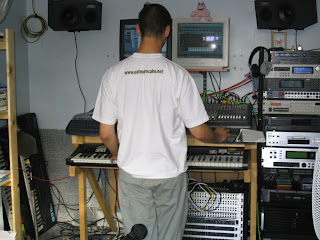So I guess it's time I wrapped up the studio history series. It seems somehow fitting that I should be doing this a matter of days after the studio has been packed away again!
So I moved home from Aberdeen about six months after my 21st birthday. My band, Charlotte Says, had long since ground to a halt and I hadn't written a song in earnest for ages. On my return home I got a part time job so I could spend two days a week pulling in a bit of pocket money, and the rest of the time pretending to be a musician!
My studio was lacking some pretty essential components at this point, so I spent time scouring free ads papers like Loot looking for bargains. (Largely, this meant sitting in the pub reading newspapers, which was a dream job really!) In the end, the good deals came from an entirely different source: perennial bargain merchants, Behringer.
Now whatever your opinion of Behringer and their products, their value for money is exceedingly high - especially when beginners are looking to expand quickly without spending their worldly savings. At the time that I moved home, they had a particularly interesting package deal that consisted of:
1 x 32-channel Eurodesk mixing console
5 x cheap condenser mics
2 x eq filter/feedback destroyers/de-essers
1 x 2 channel compressor
1 x limiter
1 x Digital EQ
1 x FX unit
All of a sudden, my studio had substance.

I was quickly becoming frustated with the 15 second limit of my Akai S01 sampler, so I also added a second-hand Akai S3000XL sampler. This gave me huge scope to change the way I worked. Now I could sample myself playing whole guitar tracks. I could layer even more drum loops. At one point, I even took a set of mics to a mate's place and multi-sampled his drum kit! I started taking samples of old 7" records - the sky was the limit!
One final major change marked this period in the studio's history: I finally retired the Atari ST and switched to running Cubase VST 3.5 on a PC.
And so it came to pass that a cheeky upstart named Andrew Briggs persuaded me to let him come round and write a dance tune using my studio. The song was toilet, but it marked the start of an unlikely writing partnership that became the band that we know and love to this day.
The studio remained pretty much unchanged for the next couple of years. Working with Andy really started me using the kit in my studio to its potential - especially in those early pre-digital audio days. The Akai S3000XL was the focus of most things, with other sounds provided mostly by the Roland JV1080. I bought the FX card for the Akai so we had more creative control over the samples and we used to spend hours drawing automation curves into Cubase to control filter sweeps, etc.
The next thing to eventually change was the mixer - the Behringer desk was great value, but the power supply was temperamental (it would sometimes blow 6 fuses before I finally switched on...) and the routing wasn't the most flexible. I bought an ex-demo 32-channel Mackie 8-bus, which was HUGE but amazing. This was my pride and joy, and a real head-turner in a bedroom studio like mine...
A few other things followed - I bought a Novation A-Station off current band member Owen, I replaced the two-channel Behringer compressor with a 4-channel Behringer one (!!), and I replaced the barely-adequate PC with a rack-mounted high-spec jobby from Digital Village. I also got more racks, patch panels and cables, external hard disks, and the studio was finally as well equipped a home studio as I could have hoped for.

With a high-spec PC, I started exploring virtual instruments. I bought a copy of Rebirth, which I loved. We'd make beats on Rebirth, then sample the individual hits onto the Akai to process them and put the beat back together in Cubase. Rebirth was the source of the majority of our drum sounds until I purchased Native Instruments' Battery 2, which in turn fuelled the start of my obsession with VSTs, along with the beginning of the end for all our outboard gear...
And that's about that. From here on in, it became a virtual world, with VSTs replacing rack-mounted sound modules and FX units gathering dusts un-patched. And that is a whole other story to tell.
The final studio kit list in full:
Mixing Desks:
Behringer Eurodesk 3282
Mackie 32 8-bus
Keyboards:
Alesis QS7
Yamaha SY85
Yamaha SY22
Roland U20
Sound Modules/Samplers:
Roland JV1080
Korg 01R/W
Novation A-Station
Yamaha TG55
Akai S3000XL
Akai S01
Sound Processing/FX:
Behringer Suppressor (x2)
Behringer Limiter
Several Behringer Patch Panels
Computer:
Digital Village-built 2.0GHz Pentium 4, 4GB RAM, 150GB System drive, 500GB audio drive
120GB external Glyph audio drive
2 x 17" CRT monitors
Other:
Phillips CD player
Sony Minidisc player
Alesis Monitor Ones
Alesis RA100 Reference Amp
Peavey T-60 electric Guitar
Jasmine by Takamine electro-acoustic guitar
Vox Standard bass guitar







No comments:
Post a Comment